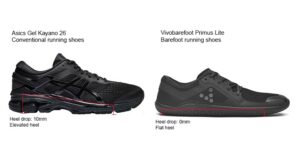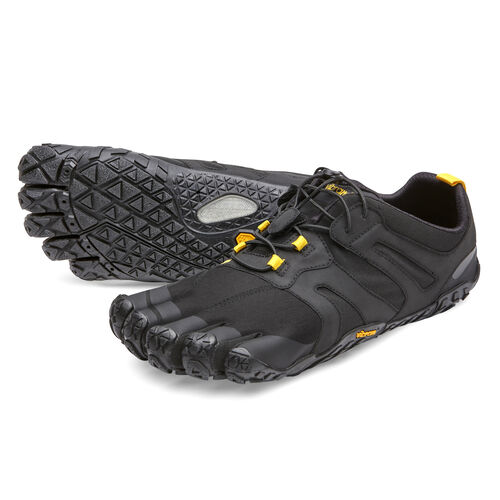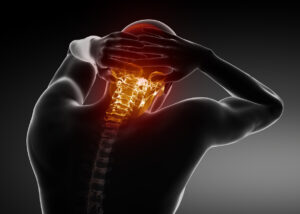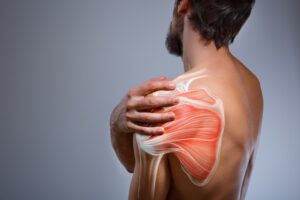Should I Run Barefoot For Fewer Injuries?
When I was in chiropractic college, the argument over whether to run shod (with shoes) or barefoot was fierce! Researchers were divided into camps and we saw the running industry was pushing minimalist and barefoot-style shoes. I remember hearing from an instructor that one of the foremost running specialists in the world, Dr Irene Davis, would make a point of running barefoot in every city she visited for a conference just to prove a joint that she (study of one) could.
 Now we are seeing a shift in the opposite direction. Shoes are getting bigger from more cushion. Other shoes have carbon fibre plates in them to help with spring! On the whole, the buzz over barefoot running seems to be dead.
Now we are seeing a shift in the opposite direction. Shoes are getting bigger from more cushion. Other shoes have carbon fibre plates in them to help with spring! On the whole, the buzz over barefoot running seems to be dead.
Nonetheless, the blog is a summary of barefoot running research that has some interesting findings! We will review the changes in gait, biomechanics and injury prevalence with barefoot running. We will also discuss whether or not it is a good idea and what aspects of barefoot running can help you become a better runner; no matter what shoes you wear. Please note that whenever I editorialize and say “barefoot running”, I mean running in a barefoot-inspired or minimalist-type shoe.
What Happens When Someone Runs Barefoot – The Biomechanics

Numerous changes in gait and biomechanics have been observed when comparing unshod (barefoot) to shod running.
Most notably, stride length is decreased, and stride rate frequency is increased. This means people take shorter strides, which typically will put less stress and impact force through the knee respectively.
The foot is more plantarflexed down and inverted inward at the subtalar joint (2) at the heel strike. This means that people land more on the middle of the foot and less on the heel (forefoot strike pattern). Also, ranges of motion at the ankle, knee and hip are reduced. The preceding factors culminate in lower contact and time airborne in barefoot gait (3-6).
Barefoot running appears to actually reduce impact forces during gait. Lieberman et al., and others have shown a forefoot favouring strike pattern is assumed in barefoot running. This increases ankle compliance and better distributes mass on ground strike.
BIOMECHANICAL CHANGES AT THE JOINTS WITH BAREFOOT RUNNING
There is up to a 50% reduction in retro patellar (behind the knee) forces with barefoot running. This is due to the forefoot is also noted with this forefoot strike pattern (7).
High-impact forces associated with running and with overtraining are argued to be a major cause of running-related injuries (7). However, this issue is highly contentious (1). Shakoor and Block have hypothesized that gait changes were partly responsible for the finding that walking barefoot results in decreased peak joint loads (less force on the joints) at the hips and knees in 75% of patients with osteoarthritis (8).
In the time that the body naturally adopts the biomechanical changes associated with barefoot running, there may be a higher risk of injury. Learning to land on the mid/forefoot without any cushion from the shoe could lead to injuries if the foot is not cushioned by a shoe or muscles/joints that are used to it (3).
WHAT MUSCULAR CHANGES COME FROM BAREFOOT RUNNING?
Adopting a forefoot strike pattern requires that the small (intrinsic) muscles inside the foot get stronger. This will eventually result in a medial longitudinal arch that is higher and better able to deform and provide improved shock attenuation (7). The muscles of the calf also show changes in barefoot running with preactivation observed via EMG (3) prior to the ground strike. Pushing off and landing forces in the foot musculature are found to be higher in the barefoot runner as well (3). There is conflicting evidence regarding changes in intrinsic foot strength associated with barefoot running (1).
Although claims of increased proprioception are often used for minimalist-type shoes or by supporters of barefoot running, no evidence has shown that proprioceptive ability is greater in unshod runners compared with shod runners. Of interest however is the following: proprioceptive ability is reduced with age and wearing of shoes. The former has been attributed to the barrier between the surface and the sole’s mechanoreceptors (11). Thicker and softer shoes lead to reduced balance control in the younger men and the elderly (12).
Can Barefoot/Minimalist Running Lead To Injuries
Some potential biomechanical problems that could lead to injury have also been associated with barefoot running. Of primary concern is the risk of deformation to the structures of the sole of the feet from repetitive running on modern materials like asphalt. For instance, there is much greater (almost double) deformation of the calcaneal heel pad with barefoot running compared to shod. This could lead to cumulative trauma over a lifetime that might leave the fat pad unable to protect the calcaneus or be a source of chronic pain due to atrophy (9).
The Achilles tendon might also be at risk in barefoot running. The more fore/midfoot strike pattern promotes biomechanical changes that stress the Achilles tendon and the posterior compartments during the contact period which might produce a greater risk of injury (9). If the flexor digitorum brevis is weak and cannot resist rapid digital dorsiflexion, plantar fasciitis might also be promoted due to the more rapid dorsiflexion of the digits in barefoot running; a proven risk factor for plantar fasciitis (10).
Does Barefoot or Minimalist Running Reduce Running Injuries
No distinct evidence is available to show that barefoot running reduces the rate of running injuries. Nonetheless, some studies do show that it can reduce risk factors of running injuries (1). The majority of running injuries occur predominantly at the ankle and are thus the focus of most barefoot running prevention studies. Barefoot conditions do seem to help with proprioceptive ability as it relates to ankle (inversion) sprains by activating plantar tactile receptors that are needed to determine foot position (13). Better lateral stability is established in barefoot conditions in cutting and running (14) along with a better discriminatory ability to sense inversion movement compared to shod individuals (15). While many other injuries can likely be prevented or treated with barefoot running, the literature is lacking in their support at this moment.
Why Minimalist Shoes Are Better Than Running In Your Bare Foot
With a loss of cushioning and direct exposure to the ground, it is inherent that there are some risks of barefoot or minimalist shoe running. The optimal surface for barefoot running has yet to be established and as mentioned, some manmade surfaces may pose a risk of injury from cumulative trauma (1). Direct exposure of the plantar surface may increase the risk of direct mechanical or thermal trauma such as glass, metal objects, thorns or extreme heat. There is an increased risk of exposure and contracting some microorganisms but this is geographically and immune status dependent. Some conditions like athlete’s foot (tinea pedis) and others actually have a reduced incidence (1). Barefoot running and activity may be contraindicated in the diabetic patient due to reduced sensation with polyneuropathy and potential increased risk of injury, ulcer and infection (1). Another potentially at-risk population might be the low back pain patient (1). A study found an increased rate of shock transmission to the back muscles and delayed muscle response time in unshod versus shod participants when forced to heel strike (16). However, we know that there is a natural transition from heel to forefoot strike patterns with the adoption of barefoot running and thus may only be appreciable in the early transition to barefoot activities.
Indication, Implementation and Minimalist Shoes
To date, there are no studies that evaluate a program or protocol for transitioning into barefoot running. Anecdotal evidence does suggest that a patient should not abruptly change to a barefoot or minimalist running style. Furthermore, a transition period ranging from three to six weeks is common, with a daily barefoot introduction that may start at around 30 minutes per day and gradually increase (1). Minimalist shoes have been found to show similar biomechanical properties (decreased peal impact force, promote forefoot strike, increase strike plantar flexion) to barefoot running and may substitute or constitute barefoot conditions (4).
I recommend to my patients that they use the biomechanical advantages that come from barefoot running but protect their feet, ankles and achilles tendons while wearing well-cushioned shoes. A well-cushioned shoe can provide better comfort, propulsion and efficiency and when combined with a shorter, faster stride and a midfoot landing pattern, all of the injury-preventing benefits of barefoot running can be maintained.
References
(1) Jenkins, D. W., & Cauthon, D. J. (2011). Barefoot Running Claims and Controversies A Review of the Literature. Journal of the American Podiatric Medical Association, 101(3), 231-246.
(2) Divert, C., Mornieux, G., Baur, H., & Mayer, F. (2005). A. Belli1 Mechanical Comparison of Barefoot and Shod Running. Int J Sports Med, 26, 593-598.
(3) Squadrone, R., & Gallozzi, C. (2009). Biomechanical and physiological comparison of barefoot and two shod conditions in experienced barefoot runners. The Journal of sports medicine and physical fitness, 49(1), 6.
(4) De Wit, B., De Clercq, D., & Aerts, P. (2000). Biomechanical analysis of the stance phase during barefoot and shod running. Journal of biomechanics, 33(3), 269-278.
(5) Lieberman, D. E., Venkadesan, M., Werbel, W. A., Daoud, A. I., D’Andrea, S., Davis, I. S., … & Pitsiladis, Y. (2010). Foot strike patterns and collision forces in habitually barefoot versus shod runners. Nature, 463(7280), 531-535.
(6) Robbins, S. E., & Hanna, A. M. (1987). Running-related injury prevention through barefoot adaptations. Medicine and science in sports and exercise, 19(2), 148-156.
(7) Kurz, M. J., & Stergiou, N. (2004). Does footwear affect ankle coordination strategies?. Journal of the American Podiatric Medical Association, 94(1), 53-58.
(8) Shakoor, N., & Block, J. A. (2006). Walking barefoot decreases loading on the lower extremity joints in knee osteoarthritis. Arthritis & Rheumatism, 54(9), 2923-2927.
(9) McClay I, Manal, K. “Lower extremity kinematic comparison of rearfoot and forefoot strikers” in proceeding of American Society of Biomechanics, p 213, Stanford, California, 1995
(10) Wearing, S. C., Smeathers, J. E., Yates, B., Sullivan, P. M., Urry, S. R., & Dubois, P. (2004). Sagittal movement of the medial longitudinal arch is unchanged in plantar fasciitis. Medicine and science in sports and exercise, 36(10), 1761.
(11) Robbins, S., Waked, E., & McClaran, J. (1995). Proprioception and stability: foot position awareness as a function of age and footware. Age and ageing, 24(1), 67-72.
(12) Robbins, S., Gouw, G. J., & McClaran, J. (1992). Shoe sole thickness and hardness influence balance in older men. Journal of the American Geriatrics Society, 40(11), 1089.
(13) Robbins, S., & Waked, E. (1998). Factors associated with ankle injuries: preventive measures. Sports Medicine, 25(1), 63-72.
(14) Stacoff, A., Steger, J. Ü. R. G., Stuessi, E. D. G. A. R., & Reinschmidt, C. H. R. I. S. T. O. P. H. (1996). Lateral stability in sideward cutting movements. Medicine and Science in Sports and Exercise, 28, 350-358.
(15) Waddington, G., & Adams, R. (2003). Football boot insoles and sensitivity to extent of ankle inversion movement. British journal of sports medicine, 37(2), 170-175.
(16) Ogon, M., Aleksiev, A. R., Spratt, K. F., Pope, M. H., & Saltzman, C. L. (2001). Footwear affects the behavior of low back muscles when jogging. International journal of sports medicine, 22(6), 414-419.




